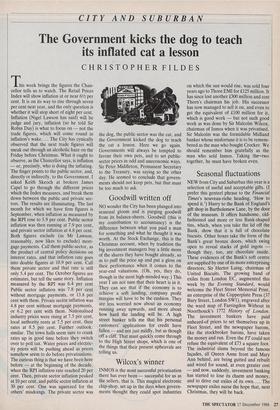CITY AND SUBURBAN
The Government kicks the dog to teach its inflated cat a lesson
CHRISTOPHER FILDES
his week brings the figures the Chan- cellor tells us to watch. The Retail Prices Index will show inflation at or near 61/2 per cent. It is on its way to rise through seven per cent next year, and the only question is whether it will stop short of eight per cent. Inflation (Nigel Lawson has said) will be judge and jury, inflation (so he told Sir Robin Day) is what to focus on — not .the trade figures, which will come round in inflation's wake.... The City has cynically observed that the next trade figures will sneak out through an alcoholic haze on the Friday before Christmas. What it ought to observe, as the Chancellor says, is inflation — or, precisely, who is doing the inflating. The finger points to the public sector, and, directly or indirectly, to the Government. I asked Keith Skeoch at brokers James Capel to go through the different prices which the Index measures, and break them down between the public and private sec- tors. The results are illuminating. The last month for which we have firm figures is September, when inflation as measured by the RPI rose to 5.9 per cent. Public sector inflation was then running at 7.9 per cent, and private sector inflation at 4.8 per cent. Both figures exclude (as Mr Lawson, reasonably, now likes to exclude) mort- gage payments. Call them public-sector, as the product of central policy decisions on interest rates, and that inflation rate goes into double figures at 10.9 per cent. Call them private sector and that rate is still only 5.4 per cent The October figures are estimates, but tell the same story. Inflation measured by the RPI was 6.4 per cent Public sector inflation was 7.8 per cent without mortgage payments, or 13.8 per cent with them. Private sector inflation was 4.8 per cent without mortgage payments, or 6.2 per cent with them. Nationalised industry prices were rising at 7.5 per cent, local authority rents at 7.5 per cent, their rates at 8.5 per cent. Further outlook: similar. The town halls seem sure to crank rates up in good time before they switch over to poll tax. Water prices and electric- ity prices will be pushing ahead as prices somehow seem to do before privatisations. The curious thing is that we have been here before — at the beginning of the decade, when the RPI inflation rate reached 20 per cent. Then, private sector inflation peaked at 10 per cent, and public sector inflation at 30 per cent. One was squeezed for the others' misdoings. The private sector was the dog, the public sector was the cat, and the Government kicked the dog to teach the cat a lesson. Here we go again. Governments will always be tempted to favour their own pets, and to set public- sector prices in odd and uneconomic ways. Sir Peter Middleton, Permanent Secretary to the Treasury, was saying so the other day. He seemed to conclude that govern- ments should not keep pets, but that must be too much to ask.


























































 Previous page
Previous page